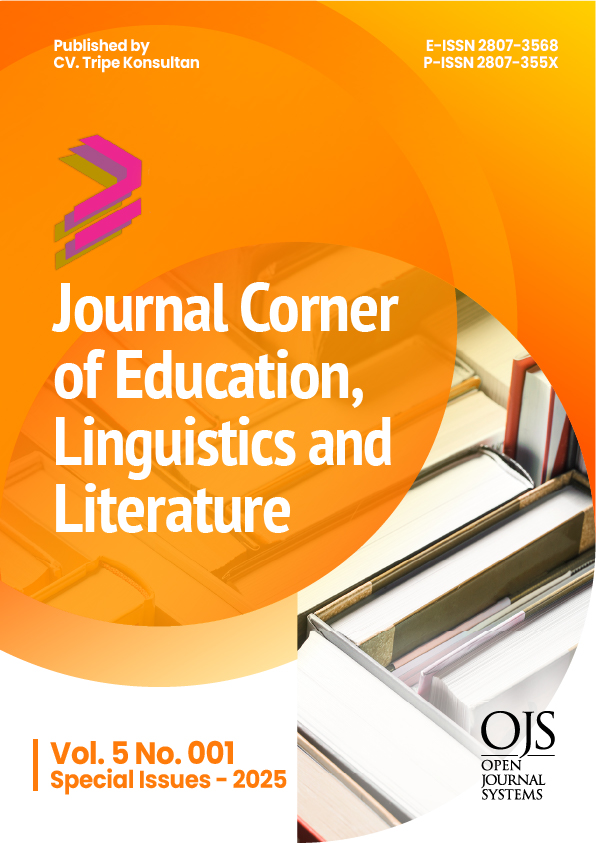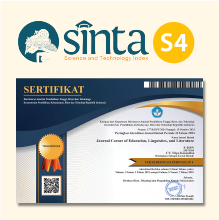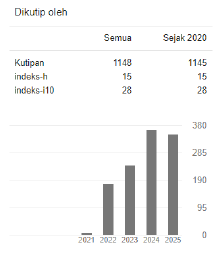Investigating the Students Anxiety in Learning English as Foreign Language at VIII Grade in SMP Negeri 9 Pematangsiantar
 https://doi.org/10.54012/jcell.v5i001.575
https://doi.org/10.54012/jcell.v5i001.575
 Abstract views: 121
Abstract views: 121
 PDF downloads: 76
PDF downloads: 76
Keywords:
Anxiety, English, Foreign Language, StudentsAbstract
Foreign Language Anxiety (FLA) encompasses feelings of fear, nervousness, and negative self-perceptions that can impede learners’ progress in acquiring a new language. Within the Indonesian educational landscape, where English is introduced as a foreign language, such anxiety presents a formidable obstacle to achieving language proficiency. This research explored the various types and intensities of foreign language anxiety experienced by eighth-grade students at SMP Negeri 9 Pematangsiantar in their English learning journey. Employing descriptive qualitative approach, this research gathered data through surveys administered to eighth-grade students, complemented by classroom observations and open-ended student responses. The findings indicated that anxiety levels are most pronounced during speaking activities and examinations, primarily driven by limited vocabulary, apprehension about making mistakes, and classroom environment factors. The predominant manifestations of anxiety included communication apprehension and fear of negative evaluation, with many students expressing feelings of embarrassment and reluctance to actively participate. To cope, students resorted to strategies such as self-research, note-taking, and seeking help from peers; however, these methods tended to be simple and unstructured, limiting their effectiveness. The research underscored teachers’ role played in cultivating a supportive, non-threatening classroom atmosphere where students feel safe to practice English without fear of judgment. Ultimately, this research enriched understanding of foreign language anxiety within Indonesian educational context and provides valuable insights for teachers aiming to implement strategies that reduce anxiety and foster greater confidence among students in English learning.
Downloads
References
Ayuningtyas, P., Mauludin, L. A., & Prasetyo, G. (2022). Investigating the anxiety factors among English for Specific Purposes students in a vocational education setting. Language Related Research, 13(3), 31-54.
Bandelow, B., & Michaelis, S. (2015). Epidemiology of anxiety disorders in the 21st century. Dialogues in clinical neuroscience, 17(3), 327-335.
Cheng, H. F., & Dörnyei, Z. (2007). The use of motivational strategies in language instruction: The case of EFL teaching in Taiwan. International journal of innovation in language learning and teaching, 1(1), 153-174.
Dörnyei, Z., & Clément, R. (2001). Motivational characteristics of learning different target languages: Results of a nationwide survey. Motivation and second language acquisition, 23(3), 399-432.
Eccles, J. S., & Roeser, R. W. (2011). Schools as developmental contexts during adolescence. Journal of research on adolescence, 21(1), 225-241.
Eysenck, M. W., Moser, J. S., Derakshan, N., Hepsomali, P., & Allen, P. (2023). A neurocognitive account of attentional control theory: how does trait anxiety affect the brain’s attentional networks?. Cognition and Emotion, 37(2), 220-237.
Fauzi, I., & Asi, N. (2023). Examining Speaking Anxiety of Indonesian Learners of English: A Case of University Students. Indonesian Journal of English Language Teaching and Applied Linguistics, 7(2), 263-275.
Gregersen, T., & Horwitz, E. K. (2002). Language learning and perfectionism: Anxious and non‐anxious language learners' reactions to their own oral performance. The Modern Language Journal, 86(4), 562-570.
Horwitz, E. K., Horwitz, M. B., & Cope, J. (1986). Foreign language classroom anxiety. The Modern language journal, 70(2), 125-132.
Jehi, T., Khan, R., Dos Santos, H., & Majzoub, N. (2023). Effect of COVID-19 outbreak on anxiety among students of higher education; A review of literature. Current Psychology, 42(20), 17475-17489.
Kianinezhad, N. (2024). Foreign language anxiety in education. JELITA, 5(1), 123-143.
MacIntyre, P. D., & Gardner, R. C. (1991). Methods and results in the study of anxiety and language learning: A review of the literature. Language learning, 41(1), 85-117.
Meydan, C. H., & Akkaş, H. (2024). The role of triangulation in qualitative research: Converging perspectives. In Principles of conducting qualitative research in multicultural settings (pp. 98-129). IGI Global.
Mustamir, M. (2024). Indonesian Efl Learners and Speaking Anxiety: Insights From a Meta-Synthetic Analysis. English Review: Journal of English Education, 12(2), 509-518.
Nassaji, H. (2015). Qualitative and descriptive research: Data type versus data analysis. Language teaching research, 19(2), 129-132.
Nasution, R. F., Manuas, M. J., Ali, M. I., Pabur, H. E., & Tatipang, D. P. (2022). How anxiety affect English achievement?: A correlational study of Indonesian EFL learners. Journal of English Culture, Language, Literature and Education, 10(2), 321-337.
Rachmawati, D. I., Jurianto. (2020). Investigating English department students’ foreign language speaking anxiety: A case study in Universitas Airlangga, Indonesia. Social Sciences, Humanities and Education Journal (SHE Journal), 1(2), 22-34.
Rahman, B., Hamid, S., & Gul, A. (2019). The impact of stress on the performance of university students in the light of Krashen’s affective filter theory. Liberal Arts and Social Sciences International Journal (LASSIJ), 3(2), 59-64.
Saltafossi, M., Heck, D., Kluger, D. S., & Varga, S. (2025). Common threads: Altered interoceptive processes across affective and anxiety disorders. Journal of Affective Disorders, 369, 244-254.
Sheen, Y. (2008). Recasts, language anxiety, modified output, and L2 learning. Language learning, 58(4), 835-874.
Sukmayadi, V., & Yahya, A. (2020). Indonesian education landscape and the 21st century challenges. Journal of Social Studies Education Research, 11(4), 219-234.
Downloads
Published
How to Cite
Issue
Section
License
Copyright (c) 2025 Debora Ombun Natio S. Pane, Bertaria Sohnata Hutauruk, Dumaris E. Silalahi

This work is licensed under a Creative Commons Attribution-ShareAlike 4.0 International License.
All articles published in the Journal Corner of Education, Linguistics, and Literature are licensed under the Creative Commons Attribution-ShareAlike License (CC BY-SA).

















